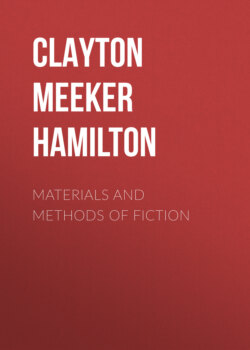Materials and Methods of Fiction

Реклама. ООО «ЛитРес», ИНН: 7719571260.
Оглавление
Clayton Meeker Hamilton. Materials and Methods of Fiction
Materials and Methods of Fiction
Table of Contents
INTRODUCTION
I
II
III
MATERIALS AND METHODS OF FICTION
CHAPTER I
THE PURPOSE OF FICTION
CHAPTER II
REALISM AND ROMANCE
CHAPTER III
THE NATURE OF NARRATIVE
CHAPTER IV
PLOT
CHAPTER V
CHARACTERS
CHAPTER VI
SETTING
CHAPTER VII
THE POINT OF VIEW IN NARRATIVE
CHAPTER VIII
EMPHASIS IN NARRATIVE
CHAPTER IX
THE EPIC, THE DRAMA, AND THE NOVEL
CHAPTER X
THE NOVEL, THE NOVELETTE, AND THE SHORT-STORY
CHAPTER XI
THE STRUCTURE OF THE SHORT-STORY
CHAPTER XII
THE FACTOR OF STYLE
INDEX
Отрывок из книги
Clayton Meeker Hamilton
With an Introduction by Brander Matthews
.....
But it is at just this point that the philosopher begins. Accepting many truths from many scientists, the philosopher compares, reconciles, and correlates them, and thus builds out of them a structure of belief. But this structure of belief remains abstract and theoretic in the mind of the philosopher. It is now the artist's turn. Accepting the correlated theoretic truths which the scientist and the philosopher have given him, he endows them with an imaginative embodiment perceptible to the senses. He translates them back into concrete terms; he clothes them in invented facts; he makes them imaginatively perceptible to a mind native and induced to actuality; and thus he gives expression to the truth.
This triple process of the scientific discovery, the philosophic understanding, and the artistic expression of truth has been explained at length, because every great writer of fiction must pass through the entire mental process. The fiction-writer differs from other seekers for the truth, not in the method of his thought, but merely in its subject-matter. His theme is human life. It is some truth of human life that he endeavors to discover, to understand, and to announce; and in order to complete his work, he must apply to human life an attention of thought which is successively scientific, philosophic, and artistic. He must first observe carefully certain facts of actual life, study them in the light of extended experience, and induce from them the general laws which he deems to be the truths which underlie them. In doing this, he is a scientist. Next, if he be a great thinker, he will correlate these truths and build out of them a structure of belief. In doing this, he is a philosopher. Lastly, he must create imaginatively such scenes and characters as will illustrate the truths he has discovered and considered, and will convey them clearly and effectively to the minds of his readers. In doing this, he is an artist.
.....